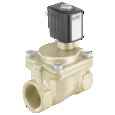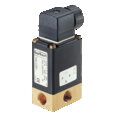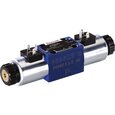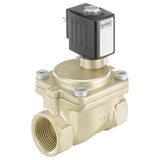Solenoid valve response time
Solenoid valve response time is the interval required for the valve to transition between open and closed states. Notably, the time it takes for a solenoid valve to activate is often different from the time it takes to deactivate, particularly when using alternating current. The C.E.T.O.P, known as the European Fluid Power Committee, has established a standardized method for measuring this response time. Despite this, it's important to note that various manufacturers may adopt different definitions or testing methods. For opening the valve, the response time is measured from the moment the solenoid is energized until the outlet pressure reaches 90% of its stable value. Conversely, the closing response time is measured from when the solenoid is de-energized until the pressure falls to 10% of the initial test pressure. These tests are typically conducted using air at a pressure of 6 bars and a temperature of 20°C.
View our online selection of solenoid valves!
Response time definition
The response time for closing the valve is defined as the duration from de-energizing the solenoid until the pressure drops to 10% of the test pressure. The test is executed with air at 6 bars at 20°C.
From an electrical standpoint, the response of a solenoid valve is not instantaneous, since a certain amount of time must pass for the coil current to overcome the coil inductance. As a result, the magnetic flux takes a certain amount of time to reach its maximum after voltage is applied to the solenoid. In addition, if alternating current is used, the coil can be energized at any phase angle of the power supply voltage. For example, if the coil is energized exactly as the voltage reaches its peak, then it will take less time for the armature to move than if the coil is energized as the voltage approaches zero.
From a mechanical point of view, it takes a certain amount of time for the armature to move the required distance after the magnetic force acted upon it overcomes the spring force. Armatures having less mass tend to operate quicker, as there is less inertia to be overcome while moving the armature.The pressure differential and type of media also affect the response time. With air, the response time will be a lot quicker than with viscous media, such as oils.
Both electrical and mechanical constraints dictate the response time of a solenoid valve. While in some applications a faster response time might be better, in some other applications a fast response time would actually be undesirable, as it could cause a water hammer effect.
Solenoid valve comparison
Not all solenoid valves have the same response time. In fact, it can vary from tens of milliseconds to several seconds. Small direct acting solenoid valves react much quicker than semi-direct or indirect acting valves. Direct operated solenoid valves have a response time of about 30 ms, while the response time of indirect operated solenoid valves can be up to 1000 ms or higher.
| ST-DA | ST-SA | ST-IA | CM-IA | DF-SA | ||||||
| Pipe | Open | Close | Open | Close | Open | Close | Open | Close | Open | Close |
| 1/8" | 30 | 30 | ||||||||
| 1/4" | 30 | 30 | 50 | 400 | ||||||
| 3/8" | 50 | 400 | 50 | 180 | 70 | 300 | 80 | 300 | ||
| 1/2" | 50 | 400 | 50 | 180 | 70 | 300 | 80 | 300 | ||
| 3/4" | 70 | 220 | 80 | 800 | 90 | 550 | ||||
| 1" | 80 | 250 | 100 | 800 | ||||||
| 1-1/4" | 120 | 280 | 100 | 800 | ||||||
| 1-1/2" | 160 | 360 | 110 | 1100 | ||||||
| 2" | 190 | 540 | 120 | 1300 | ||||||
Response time in miliseconds for different solenoid valves models (JP Fluid Control).
Electric ball valves that are used in HVAC or irrigation, have a response time in the order of a few seconds and therefore carry a low risk of water hammer. In applications such as zone valves, electric ball valves are preferred over solenoid valves.
Water hammer
Water hammer is a phenomenon that occurs when the flow of a fluid inside a pipe system is abruptly stopped by a closing valve. Once the valve closes, the water coming towards the valve reflects just as a wave does, causing a pressure transient upstream of the valve. Depending on several factors, such as flow rate, upstream pipe length and valve closing time, the pressure transient may be large enough to cause physical damage to pipes, joints or the valve itself, resulting in ruptures or leaks. In other cases, the only symptom of a water hammer is noise that sounds like a hammer banging on a pipe. The water hammer effect is more often a problem in high flow applications.
This effect can be prevented or reduced by taking the following measures:
- Increase the pipe diameter (which reduces flow speed),
- install a water hammer arrestor, or
- choose a solenoid valve or other valve type that has a slower response time, such as an electric ball valve.
- The proper fixation of valves and piping can prevent resonation in the system and reduce the noise level as well.












